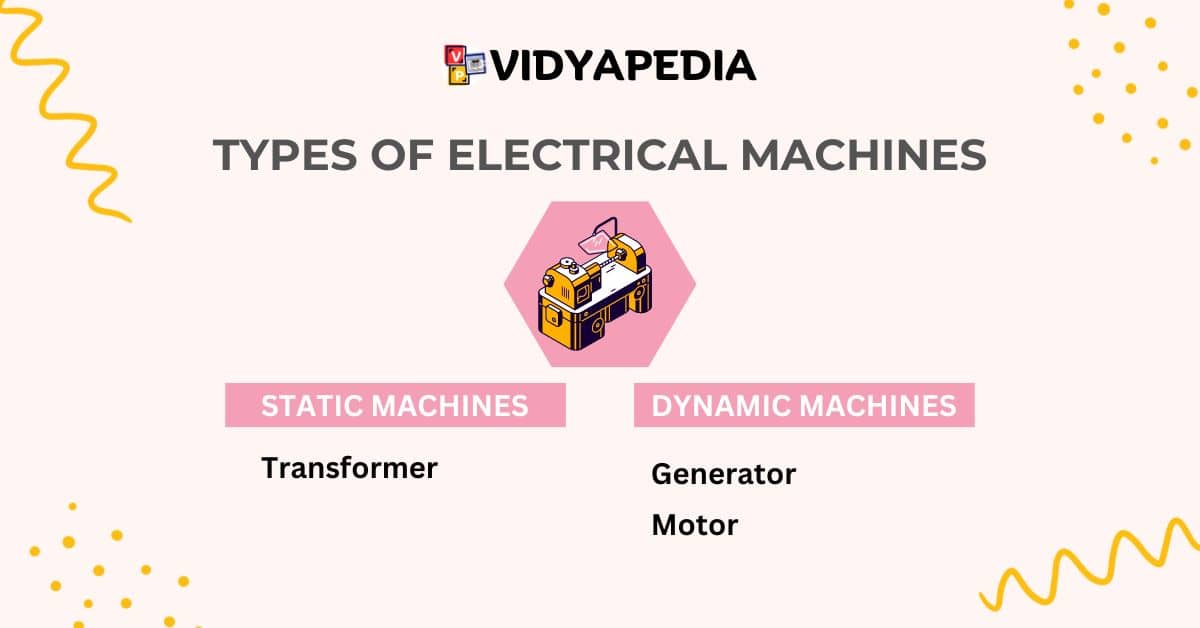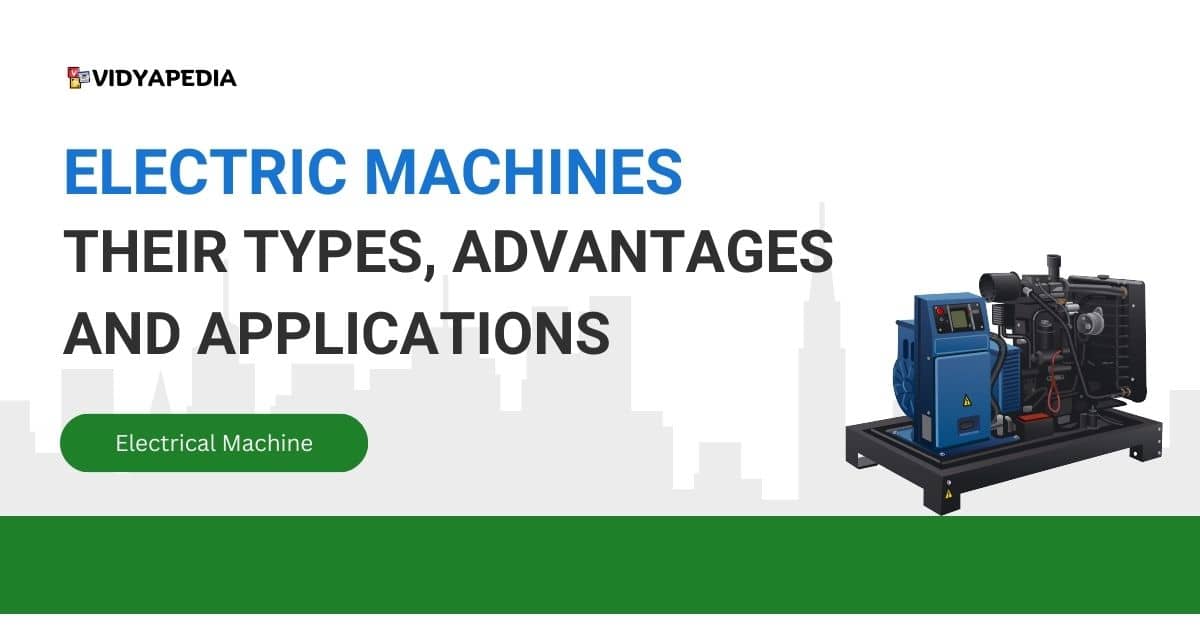Key Points
Electric Machines: They convert mechanical energy into electrical energy and vice versa
Transformer: Transfers electrical energy between circuits via electromagnetic induction. Example: Power plants use transformers to increase voltage for transmission.
Electric Motor: Converts electrical energy into mechanical motion using electromagnetic fields. Example: Electric fans use motors to create airflow.
Generator: Converts mechanical energy into electrical energy through electromagnetic induction. Example: Portable generators provide backup power during outages.
Induction Motor: A type of electric motor where rotating magnetic fields induce current in the rotor. Example: Household washing machines often use induction motors.
Synchronous Motor: Operates at a constant speed synchronously with the supply current. Example: Large industrial compressors use synchronous motors for precise speed control.
What is an electrical machine?
Electrical machines are devices that convert electrical energy into mechanical energy or vice versa. For example, a fan uses electrical energy to create mechanical movement (the blades spinning), while a generator converts mechanical energy (like from a spinning turbine) into electrical energy.
Types Of Electrical Machine
Electrical machines can be categorized into two main types: static electrical machines and dynamic electrical machines.

Static electrical machines do not have any moving parts. Their primary function is to adjust the voltage of alternating current (AC) without changing the amount of power. They operate based on the principle of electromagnetic induction. For example, transformers are a type of static machine that either increases or decreases voltage levels. They are crucial in power grids, where they step up voltage for efficient long-distance transmission and step it down for safe distribution to homes and businesses.
Dynamic electrical machines have moving parts and are responsible for converting energy from one form to another. Electric motors and generators are examples of dynamic machines. Electric motors convert electrical energy into mechanical movement, driving devices like fans and washing machines. Generators, on the other hand, convert mechanical energy (from spinning turbines, for instance) into electrical energy. Power plants often use generators to produce electricity, making them a key example of dynamic electrical machines.
More Categories To Read: Power System , Electric Machine
Transformer
A transformer is an electrical machine designed to change the voltage of alternating current (AC) while keeping the power constant. By using electromagnetic induction, it either increases or decreases the voltage based on the ratio of coils in its primary and secondary windings. This process allows efficient transmission and distribution of electrical power across various stages of the power system.
Different Types oF Transformer
| Category | Subcategory | Description |
| Uses | Power Generation | Steps up voltage for transmission |
| Transmission | Transforms high voltage for long-distance travel | |
| Distribution | Steps down voltage for end-users | |
| Voltage Level | Step-Up | Increases voltage |
| Step-Down | Decreases voltage | |
| Isolation | Maintains voltage and provides safety | |
| Design Criteria | Core Material | Laminated silicon steel |
| Windings | High-conductivity copper or aluminum | |
| Cooling | Air, oil, or fluid cooling systems | |
| Insulation Type | Oil-Immersed | Uses insulating oil for cooling and insulation |
| Dry-Type | Uses solid insulation materials like epoxy or paper | |
| Operation Phase | Single-Phase | Used in residential and small commercial settings |
| Three-Phase | Used in industrial and large commercial settings | |
| Based on a magnetic field | Core-Type | Magnetic flux passes through the core, with windings around it |
| Shell-Type | core surrounds the windings, improving efficiency | |
| Auto-Transformer | Single-winding serves as both primary and secondary |
Motors
Definition: A motor is a device that transforms electrical energy into mechanical motion. It operates by creating rotational movement through electromagnetic forces, making it essential for powering everything from household appliances to industrial equipment.
Types of Motors
DC Motors:
- Brushed DC Motor: Uses brushes to deliver electrical current to the motor’s windings. This type is common in small devices like drills and fans.
- Brushless DC Motor (BLDC): Replaces brushes with electronic controls for better efficiency and reliability. It’s often found in computer fans and electric vehicles.
AC Motors:
- Synchronous Motor: Operates at a speed synchronized with the AC supply frequency, making it suitable for applications requiring precise speed control, such as in certain machinery.
- Asynchronous Motor (Induction Motor): The most widely used type, which does not need to synchronize with the supply frequency. It’s commonly used in household appliances like washing machines and in various industrial processes.
Examples of Motor
- Brushed DC Motor: Electric drills, small household fans
- Brushless DC Motor: Computer cooling fans, electric cars
- Synchronous Motor: Precision instruments, certain types of clocks
- Asynchronous Motor: Washing machines, industrial conveyor systems
Generators
Definition: A generator converts mechanical energy into electrical energy by rotating a coil within a magnetic field to produce electric current. They are crucial for generating power in various settings.
Types of Generators
AC generators (alternators):
- Synchronous Generator: Produces alternating current (AC) and runs at a speed matched to the frequency of the output current. These are commonly used in power plants and large-scale power generation.
- Asynchronous Generator: Produces AC but does not require synchronization with the frequency. Often used in wind turbines and other variable-speed applications.
DC Generators:
- Separately Excited Generator: Has an external power source for its field windings, providing a stable output voltage. It’s used in situations where a consistent DC supply is needed.
- Self-Excited Generator: Uses its own output to energize the field windings.
- Series Generator: Field windings are in series with the armature, used where a high current is needed.
- Shunt Generator: Field windings are in parallel with the armature, suitable for stable voltage output.
- Compound Generator: Combines both series and shunt windings to provide better voltage regulation.
Advantages of Electrical Machines:
- Efficiency: Electrical machines, such as motors and generators, are highly efficient in converting energy from one form to another, minimizing energy loss during the process.
- Versatility: Electrical machines come in various types and sizes, making them adaptable to different applications, from small household appliances to large industrial machinery.
- Reliability: With proper maintenance, electrical machines have long operational lifespans, ensuring consistent and reliable performance over time.
- Automation and Control: They can be easily integrated with automation systems, allowing precise control over speed, torque, and power output, which is essential for modern manufacturing processes.
- Environmental Benefits: Many electrical machines, especially those powered by renewable energy sources, contribute to reducing carbon emissions and promoting sustainability.
- Cost-Effectiveness: Over time, electrical machines can be more cost-effective than their mechanical counterparts due to lower operational and maintenance costs.
- Energy Conversion: Electrical machines efficiently convert electrical energy into mechanical energy and vice versa, which is essential in powering a wide range of devices and systems.
- Safety: Electrical machines, when properly installed and maintained, offer safer operation compared to many mechanical systems, as they often involve fewer moving parts and lower risks of mechanical failure.
- Compactness: Modern electrical machines are designed to be compact and lightweight, making them suitable for applications where space is limited.
- Low Noise Operation: Compared to internal combustion engines or other mechanical systems, electrical machines generally operate more quietly, contributing to a more pleasant working environment.
Real-Life Applications of Electrical Machines:
- Agriculture: Electrical machines drive equipment like irrigation pumps, threshers, and milking machines, enhancing productivity and efficiency in farming operations.
- Transportation: Electric motors are used in electric vehicles (EVs), trains, and ships, providing an efficient and environmentally friendly alternative to traditional combustion engines.
- Manufacturing: Industrial motors drive machinery in factories, such as conveyor belts, pumps, and robotic arms, enabling mass production and automation.
- Power Generation: Generators convert mechanical energy into electrical energy in power plants, including those using renewable sources like wind and hydropower, supplying electricity to homes and businesses.
- Household Appliances: Electrical machines are found in common household items like washing machines, refrigerators, and air conditioners, making daily chores easier and more efficient.
- Healthcare: Electric machines power medical devices like MRI machines, ventilators, and surgical tools, playing a critical role in modern healthcare and diagnostics.
- Construction: Electric motors are used in cranes, drills, and other construction equipment, facilitating the building of infrastructure and reducing the reliance on manual labor.
- Aerospace: Electric machines are utilized in aircraft systems, including actuators for flight control surfaces and electric propulsion in modern aircraft designs.
- Renewable Energy Systems: Wind turbines and hydroelectric plants use electrical generators to convert kinetic energy from wind and water into electricity, contributing to sustainable energy production.
- Consumer Electronics: Small electric motors are integral to the functioning of gadgets like smartphones, laptops, and cameras, powering components like vibration motors and cooling fans.


